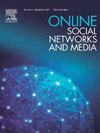‘Toxic’ memes: A survey of computational perspectives on the detection and explanation of meme toxicities
IF 2.9
Q1 Social Sciences
引用次数: 0
Abstract
Internet memes are multimodal, highly shareable cultural units that condense complex messages into compact forms of communication, making them a powerful vehicle for information spread. Increasingly, they are used to propagate hateful, extremist, or otherwise ‘toxic’ narratives, symbols, and messages. Research on computational methods for meme toxicity analysis has expanded significantly over the past five years. However, existing surveys cover only studies published until 2022, resulting in inconsistent terminology and overlooked trends. This survey bridges that gap by systematically reviewing content-based computational approaches to toxic meme analysis, incorporating key developments up to early 2024. Using the PRISMA methodology, we extend the scope of prior analyses, resulting in a threefold increase in the number of reviewed works. This study makes four key contributions. First, we expand the coverage of computational research on toxic memes, reviewing 158 content-based studies, including 119 newly analyzed papers, and identifying over 30 datasets while examining their labeling methodologies. Second, we address the lack of clear definitions of meme toxicity in computational research by introducing a new taxonomy that categorizes different toxicity types, providing a more structured foundation for future studies. Third, we observe that existing content-based studies implicitly focus on three key dimensions of meme toxicity—target, intent, and conveyance tactics. We formalize this perspective by introducing a structured framework that models how these dimensions are computationally analyzed across studies. Finally, we examine emerging trends and challenges, including advancements in cross-modal reasoning, the integration of expert and cultural knowledge, the increasing demand for automatic toxicity explanations, the challenges of handling meme toxicity in low-resource languages, and the rising role of generative AI in both analyzing and generating ‘toxic’ memes.
“有毒”模因:对模因毒性检测和解释的计算视角的调查
网络模因是多模态的、高度可共享的文化单位,它将复杂的信息浓缩成紧凑的交流形式,使其成为信息传播的强大载体。越来越多地,它们被用来传播仇恨、极端主义或其他“有毒”的叙事、符号和信息。在过去的五年中,模因毒性分析的计算方法的研究得到了显著的扩展。然而,现有的调查只涵盖了2022年之前发表的研究,导致术语不一致,趋势被忽视。本调查通过系统地回顾基于内容的有毒模因分析计算方法,结合到2024年初的关键发展,弥合了这一差距。使用PRISMA方法,我们扩展了先前分析的范围,导致审查作品的数量增加了三倍。这项研究做出了四个关键贡献。首先,我们扩大了有毒模因的计算研究范围,回顾了158项基于内容的研究,其中包括119篇新分析的论文,并在检查其标记方法的同时识别了30多个数据集。其次,我们通过引入一种对不同毒性类型进行分类的新分类法,解决了计算研究中模因毒性缺乏明确定义的问题,为未来的研究提供了更结构化的基础。第三,我们观察到现有的基于内容的研究隐含地关注了模因毒性的三个关键维度——目标、意图和传递策略。我们通过引入一个结构化框架来形式化这一观点,该框架对这些维度如何在研究中进行计算分析进行建模。最后,我们研究了新兴趋势和挑战,包括跨模态推理的进步、专家和文化知识的整合、对自动毒性解释的日益增长的需求、在低资源语言中处理模因毒性的挑战,以及生成式人工智能在分析和生成“有毒”模因方面的日益重要的作用。
本文章由计算机程序翻译,如有差异,请以英文原文为准。
求助全文
约1分钟内获得全文
求助全文
来源期刊

Online Social Networks and Media
Social Sciences-Communication
CiteScore
10.60
自引率
0.00%
发文量
32
审稿时长
44 days
 求助内容:
求助内容: 应助结果提醒方式:
应助结果提醒方式:


